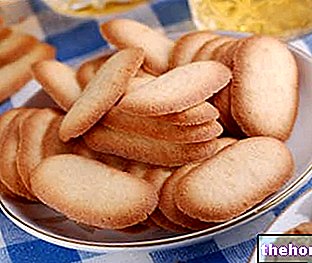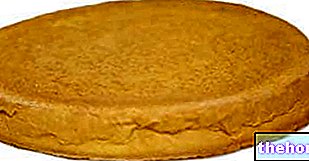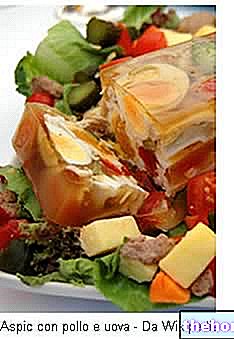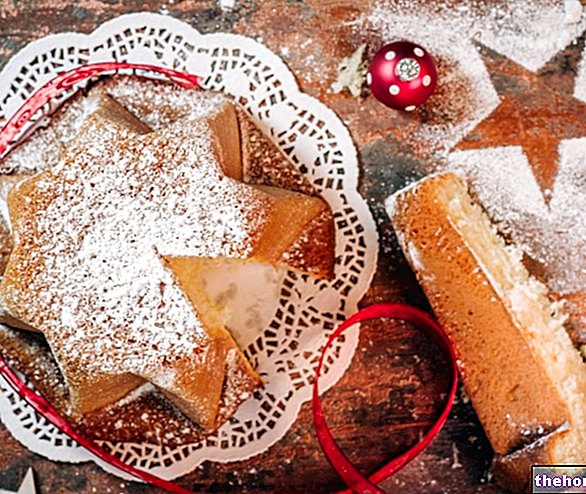Generality
Krapfen is the name of a sweet and fried food typical of the Austrian territory.
.jpg)
Despite the original krapfen recipe is one, there are many variations of interest: cooking fat, sugar, flour, filling, etc.
The donut is a highly caloric product, rich in fats, carbohydrates and often cholesterol too. Therefore, it does NOT lend itself to all types of diets and its frequent consumption could easily induce a nutritional imbalance.
Description
The most curious feature of krapfen is the difference between the raw and cooked form. Like many sweets inflated by frying carbon dioxide, this food also grows in volume exponentially. The portioning of the "raw" pasta in fact involves the cutting of discs with a diameter of 5-10 centimeters, only about 5-10 millimeters thick. ; at the end of the heat treatment, the donuts obtained from these discs will have increased up to 15 times their total volume.
Ready to eat, the "fresh" donut has a slightly flattened spherical shape; the color is "pale hazelnut" on the vertices (which come into contact with the cooking fat) and tends to be yellow on the transverse line, where the surface does not interact as well with the heat exchanger. Better to be wary of donuts with a light and uniform color, hypothetically less cooked and therefore indigestible, or those that are too dark, potentially overcooked or cooked in excessively depleted and dirty fat.
Typically, donuts are coated with sugar or powdered sugar, the texture of which can be another indicator of good or poor quality of the product. In fact, a perfectly fried dessert, therefore not soaked in oil and well buffered, leaves the sugar completely dry; on the contrary, when the sugar thickens and becomes translucent, it means that the donut is definitely too greasy and / or stale and / or badly preserved.
Being a sweet filling, on one of the two sides of the CONTEMPORARY donut the syringe or pastry bag inlet is almost always clearly visible. The original filling is rosehip, plum or apricot jam; on the other hand, in Italy donuts with custard cream, diplomatic cream and hazelnut and cocoa cream (like Nutella) are even more widespread.
ATTENTION! It is not certain that the transshipment of the contents from the hole necessarily indicates an "abundance of the filling. In fact, the internal space dedicated to the filling" is formed spontaneously by leavening of the dough during cooking. The carbon dioxide, while expanding with heat, remains trapped in the gluten of the dough, creating a "sponge" characterized by more or less dense and voluminous cells. The lower density of the dough (the more leavened one) allows it to accommodate a greater volume of filling but, at the same time, a donut with too much yeast or poorly kneaded contains large bubbles that make it collapse or explode during the first bite. In this sense, the quality of the flour (presence of gluten) also plays a fundamental role. On the other hand, a donut that is too "massive" (therefore with small and dense leavening cells) has little filling and is more daring to chew and mix with saliva
Historical Notes and Etymology
As anticipated, krapfen is a native dessert of Austria. More precisely, it seems that it was born in the city of Graz, the capital of Styria. In the local gastronomy, krapfen has the task of enriching carnival stalls, a function which emulated in many other nations that have absorbed the recipe.
The origin of the term "krapfen" does not boast the same clarity. In this regard, two distinct theories have been formulated: the first concerns the "ancient German noun which indicates" pancake ", or" krafo "; the second indicates the surname of the pastry chef who, at the end of the 17th century AD, invented krapfen: Veronica Krapft.
Krapfen recipe
Here is the hypothetically "original" recipe for donuts. The modern donut, in Italy, is NOT filled before cooking, but after!
Ingrediants
- soft wheat flour type 00 250g
- 25g brewer's yeast
- whole milk 125ml
- whole egg n ° 1
- egg yolks n ° 2
- granular sugar 20g
- grated zest of 1 lemon
- melted butter 60g
- apricot jam 150g
- lard for frying 500g
- vanilla icing sugar QB
- salt a pinch.
_2.jpg)
Nutritional values (per 100 g of edible portion)
Edible part
100%
Waterfall
34.3g
Proteins
5.9g
Prevailing amino acids
-
Limiting amino acid
-
Lipids TOT
21.1g
Saturated fatty acids
10.4g
Monounsaturated fatty acids
8.4g
Polyunsaturated fatty acids
2.3g
Cholesterol
134.5mg
TOT Carbohydrates
37.8
Starch
22.47g
Soluble sugars
15.4g
Dietary fiber
1.2g
Soluble fiber
- g
Insoluble fiber
- g
Power
355.3kcal
Sodium
28.9mg
Potassium
108.4mg
Iron
0.9mg
Football
39.1mg
Phosphorus
93.6mg
Thiamine
0.08mg
Riboflavin
0.12mg
Niacin
0.72mg
Vitamin A
103.6RAE
C vitamin
2.5mg
Vitamin E
0.63mg
Method
Dissolve the yeast in a little warm milk with a little flour; place this batter to rise for at least 2 hours in a warm place and in a sealed container.
Once the volume of the batter has doubled, gradually add the flour, a pinch of salt, the beaten eggs and yolks, the granulated sugar and the lemon peel. Stir vigorously and incorporate the melted butter.
Spread on a floured surface to a thickness of about 1cm and, with a pastry bowl, cut into discs of about 8cm. At the center of the discs, place a spoonful of jam and close with another empty disc, taking care to tighten the edges.
Leave to rise for 2 hours in a warm place and in a sealed container.
Fry them in abundant lard, dry them VERY WELL and sprinkle them with vanilla icing sugar.
NB. If you want to stuff it after cooking, it is not necessary to overlap the discs, they will be fried individually and filled with a pastry bag or with a special syringe.
Nutritional characteristics
The nutritional values of donuts are very different according to the recipe. The variables that most of all compromise the supply of energy and nutrients are the fat used and the filling.
In the event that lard or butter is used, the intake of saturated fats and cholesterol significantly increases with a negative effect on cholesterolemia. At the same time, the choice of filling varies between jam, custard, diplomatic cream and cocoa hazelnut cream ( nutella type); in the latter case, the fat intake already very high for the frying process, increases further making the preparation a caloric BOMB. After chocolate, in second place (for fatness) we find the diplomatic cream (erroneously called chantilly) consisting of a part of whipped cream. Finally, custard and jam are added to the list, instead richer in carbohydrates (simple and, in the pastry, also complex). Obviously, the presence of eggs (already intrinsic to "dough) in custard or diplomatic helps to increase the total cholesterol share of donuts. Then, the omnipresent richness of sucrose makes it unsuitable for feeding the diabetic.
The donut is NEVER a suitable product for the nutrition of the overweight person or the one suffering from metabolic diseases. The table shows the nutritional values of the recipe mentioned in the previous paragraph, while below is the video of a much lighter and healthier variant: light baked donuts.
Baked Light Donuts - Non Fried Krapfen
Problems with playing the video? Reload the video from youtube.
- Go to the Video Page
- Go to the Video Recipes Section
- Watch the video on youtube
For those looking for an even lighter variant, we recommend the video recipe of the very soft donuts with potatoes.
Other Foods - Sweets Aspic Cantucci Caramel Candied Citron Chocolate White Chocolate Codette Chantilly Cream Custard Crepes Ice Cream Granita Ice Cream Jam and Jam Marshmallow Marzipan Honey Mustard Nutella Sponge Cake Pandoro Panettone Shortcrust Pastry Sorbet Strudel Nougat Wafer Zabaione Iced Sugar OTHER ITEMS Alcoholic Alcohol Categories Meat Cereals and derivatives Sweeteners Sweets Offal Fruit Dried fruit Milk and derivatives Legumes Oils and fats Fish and fishery products Salami Spices Vegetables Health recipes Appetizers Bread, Pizza and Brioche First courses Second courses Vegetables and Salads Sweets and Desserts Ice creams and sorbets Syrups, Spirits and grappas Basic Preparations ---- In the Kitchen with Leftovers Carnival Recipes Christmas Recipes Diet Recipes Light Recipes Women's Day, Mum, Dad Functional Recipes International Recipes Easter Recipes Recipes for Celiacs Recipes for Diabetics Recipes for the Holidays Recipes for S an Valentino Vegetarian Recipes Protein Recipes Regional Recipes Vegan Recipes




























